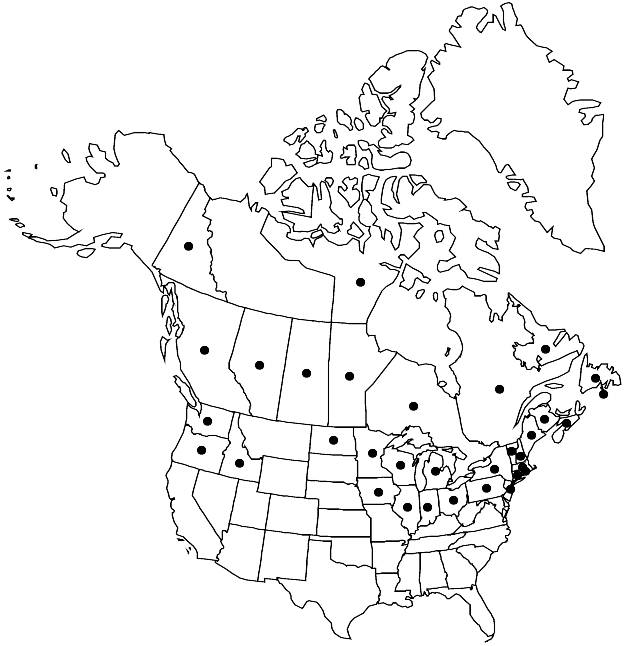Salix pedicellaris
Fl. Amer. Sept. 2: 611. 1813.
Plants 0.2–1.5 m, forming clones by layering. Stems erect, decumbent or trailing; branches gray-brown, glabrous; branchlets yellowbrown or red-yellow, glabrous or puberulent (hairs straight, minute, inner membranaceous bud-scale layer free, not separating from outer layer). Leaves: stipules absent or rudimentary; petiole (deeply to shallowly grooved adaxially), 3–8 mm, (glabrous or puberulent); largest medial blade narrowly oblong, oblong, narrowly to broadly elliptic, narrowly oblanceolate or oblanceolate, 19–53 (–69) × 5–20 mm, 1.8–4.9 times as long as wide, base convex or rounded, margins flat or slightly revolute, entire, apex acute, convex, or rounded, abaxial surface glabrous, adaxial dull, glaucous, glabrous (rarely very sparsely short-silky, hairs usually white, sometimes also ferruginous); proximal blade margins entire; juvenile blade (reddish or yellowish green), glabrous, puberulent, or sparsely pubescent abaxially, (hairs usually white, sometimes also ferruginous). Catkins: staminate 11–21 × 4–8 mm, flowering branchlet 3–12 mm; pistillate loosely flowered, stout or subglobose, 14–37 × 5–14 mm, flowering branchlet 7–25 mm; floral bract tawny or light rose, 0.8–1.6 mm, apex rounded, entire, abaxially very sparsely hairy distally, hairs straight or wavy. Staminate flowers: abaxial nectary absent, adaxial nectary oblong or narrowly oblong, 0.5–1.1 mm; filaments distinct or connate less than 1/2 their lengths, glabrous, or hairy basally or on proximal 1/2; anthers (yellow), ellipsoid, 0.4–0.6 mm. Pistillate flowers: abaxial nectary absent, adaxial nectary oblong, 0.2–1.4 mm, shorter than stipe; stipe 2.1–3.2 mm; ovary obclavate, often glaucous, glabrous, beak abruptly tapering to styles; ovules 4–6 per ovary; styles connate or distinct 1/2 their lengths, 0.1–0.2 mm; stigmas flat, abaxially non-papillate with rounded tip, or 2 plump lobes, 0.2–0.25–0.36 mm. Capsules 4–8 mm. 2n = 38, 57, 76.
Phenology: Flowering mid Apr-mid Jul.
Habitat: Sphagnum bogs, fens, black spruce treed bogs
Elevation: 0-1400 m
Distribution

St. Pierre and Miquelon, Alta., B.C., Man., N.B., Nfld. and Labr., N.S., Nunavut, Ont., Que., Sask., Yukon, Conn., Idaho, Ill., Ind., Iowa, Maine, Mass., Mich., Minn., N.H., N.J., N.Y., N.Dak., Ohio, Oreg., Pa., R.I., Vt., Wash., Wis.
Discussion
Salix pedicellaris is found in Nunavut on Akimiski Island in James Bay and on the Belcher Islands in Hudson Bay.
Salix pedicellaris is very distinct with decumbent habit, leathery, glabrous leaves that are glaucous on both surfaces, loosely flowered catkins, ovaries reddish, glabrous and often glaucous, and stipes 2.1–3.2 mm. In the flora area, it hybridizes with six other species (see below). This compares with the closely related European S. myrtilloides Linnaeus, which is reported (B. Jonsell and T. Karlsson 2000+, vol. 1) to hybridize with seven species. The distinctive appearance may make hybrids easily recognizable but it is complex cytologically.
Hybrids:
Salix pedicellaris forms natural hybrids with S. arctica, S. argyrocarpa, S. athabascensis, S. chlorolepis, S. glauca var. cordifolia, S. pedicellaris, and S. pellita. Hybrids with S. candida and S. eriocephala have been reported (M. L. Fernald 1950) but no convincing specimens have been seen.
Salix pedicellaris × S. pellita (S. ×jamesensis Lepage) was described from the west coast of James Bay, Ontario. It is to be expected throughout northern Ontario and Quebec. According to E. Lepage (1964), its yellowish midveins and the hairiness of floral bracts superficially resemble those of S. pellita forma psila C. K. Schneider (syn. S. pellita forma denudata), but its reticulate leaf venation resembles that of S. pedicellaris.
Selected References
None.
Lower Taxa
"-0.36mm" is not declared as a valid unit of measurement for this property.
